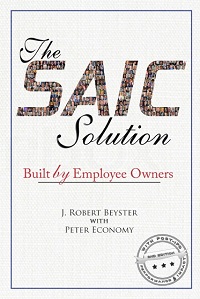A Long-Term Energy Solution (Part 2 of 3)
6 Comments Published by Dr. Beyster October 6th, 2009 in Energy, Technology.In this second in a three-part series on a long-term energy solution for our nation (Part 1 is here), I take a look at the major alternative sources of energy and consider their promise (and potential failings) for the future. While there is an ongoing — and often heated — debate about how many more years the supply of easily accessible and affordable fossil fuels will be able to feed the growing global appetite for them, there is much research going on to find cost-effective (and, whenever possible, infinitely renewable) alternatives.
The Administration has set a goal that 10 percent of U.S. electricity will be derived from renewable resources by 2012, growing to 25 percent by 2025. Regardless of your personal beliefs, there is now a strong economic case — and government impetus — for this research, and for large-scale alternative-energy production.
The Major Categories of Alternative Sources of Fuel
When considering sources of alternative energy, one is first met with a bit of a conundrum. What sources of energy should today be considered “conventional,” and what sources should be classed as alternatives to these conventional sources?
It is generally agreed that the fossil fuels most commonly used today — oil and petroleum, natural gas, and coal — are the main conventional sources of fuel. Many observers consider nuclear to be a conventional fuel source, and they may be right when it comes to the current fission-based reactors. I would argue that fusion-based reactors are an alternative (and infinitely renewable) source of energy, but one that won’t become a reality in the foreseeable future.
The major categories of alternative sources of fuel today include:
- Bioenergy
- Geothermal
- Hydrogen
- Hydropower
- Solar
- Wind
While each of these sources of energy is currently in use, the use is limited and significantly less than the use of conventional fossil fuels. As I pointed out in Part 1 of this article, alternative, renewable sources (non-nuclear and hydro) provide for less than 5 percent of our energy needs today, and we currently rely on fossil fuels for about 83.5 percent of our energy needs. Based on government projections, this situation will not change much between now and 2030. However, beyond 2030, I expect alternative sources of energy to play a rapidly increasing role in our overall global energy picture.
I will next consider each of the major sources of alternative energy, and their prospects for the future.
Bioenergy
This area of inquiry is the most exciting to me personally. Bioenergy — derived from biomass, which is simply plant-based organic matter available on a renewable basis — includes a wide variety of energy sources and fuels, such as ethanol derived from corn, sugar cane, and other crops; reclaimed vegetable oils (often from restaurant deep-fat fryers); biodiesel; methane from cattle manure; experimental sources such as algae; and much more. According to the Department of Energy, bioenergy currently ranks second only to hydropower in renewable U.S. primary energy production, accounting for 3 percent of the primary energy production in the United States today.
While bioenergy shows continued promise for the future, we recently saw how the diversion of a portion of our country’s supply of corn into ethanol production drove up worldwide prices for the grain — and for the many other products that depend on it. There is also the question of what to do with the waste product from large-scale bioenergy production, and the large amounts of water required to produce it. Regardless, it is my strong belief that the problems will be addressed effectively, and that these sources of bioenergy — and others yet to be developed — will one day directly replace the majority of liquid and gaseous fossil fuels used today.
Geothermal
Using natural heat sources from just below the earth’s surface — to deep underground — geothermal is a renewable and non-polluting source of energy. In the best case, the heat derived from geothermal sources is often sufficient to create the steam necessary to drive turbines that can be used to generate electricity. However, even lower-temperature geothermal energy can be used to heat homes and buildings through networks of pipes.
While geothermal offers these advantages and more, it is by nature quite localized. Many of the most active geothermal areas in this country are located in the West — including Alaska and Hawaii — and often in national parks such as Yellowstone. The Department of Energy’s Geothermal Technologies Program anticipates that they will receive about $400 million in funding for geothermal research from the American Recovery and Reinvestment Act of 2009. This should give a boost to the technology and its increased real-world application.
Hydrogen
Hydrogen is already in limited use as a fuel for automobiles — both as a direct fuel source that can be burned in an internal combustion engine, and by way of hydrogen-oxygen proton exchange membrane fuel cells. Hydrogen has the great advantage that it is particularly clean burning, with the only notable waste product being water — H2O. While still experimental, vehicles using hydrogen fuel cells have been found to be two to three times more efficient than conventional gasoline vehicles.
Unfortunately, hydrogen must currently be stored in heavy tanks — either as a gas under high pressure, or as a liquid at very low temperature — making transport of hydrogen in a typical vehicle problematic. Not only that, but the actual production of large quantities of hydrogen requires significant amounts of electricity, which for the most part is currently generated in fossil fuel-burning power plants. This will become less of a problem as alternative sources of electric-power generation become more widespread.
Hydropower
If you have ever been to Niagara Falls or Hoover Dam, you’ve seen hydropower in all its glory. This alternative source of energy has been with us for millennia, but it is now getting renewed attention and research. Today, more than 2,000 hydropower plants are in use in the United States, and their combined power output makes hydroelectric power our largest current source of renewable energy.
However, much of the current excitement for the future of hydropower is in small hydroelectric generators — from about 1 to 30 megawatts (MW) of output — and micro hydroelectric generators, which can be used in a small stream or sluice to power individual homes. In addition, research into converting the up-and-down motion of waves and tides is being conducted and is beginning to bear fruit. Given the fact that approximately 70 percent of the earth’s surface is covered with water, and the vast majority of this water is in constant motion, hydropower offers some promise for our future energy needs.
Solar
Each year, approximately 700 quadrillion kilowatt-hours of solar energy reaches the earth’s surface in a day-and-night cycle that has already gone on for more than 4 billion years, and that will likely continue for many billions of years more. People are taking advantage of this free, clean, and infinitely renewable source of energy in many different ways, primarily through passive (using architecture to take advantage of the position of the sun during different times of the day and year) or active (using photovoltaic cells to directly generate electricity, or solar thermal collectors to generate heat) solar energy systems.
New photovoltaic cells are being developed with the goal of raising current efficiency from about 20 percent to 60 percent or more. In my estimation, it’s only a matter of time before this goal will be reached. China in particular is emerging as a global leader in photovoltaic cell technology, and with the support of the Chinese government, the country now produces more photovoltaic cells than any other — including the United States.
Wind
Just as the water that covers the earth is in constant motion — oceans, seas, and lakes surging, and rivers and streams running — so too is the earth’s atmosphere. According to the Department of Energy, wind today powers millions of American homes and businesses and is one our nation’s fastest-growing sources of energy. Many new wind farms are in the planning stage in this country, with some in the construction phase. The amount of energy derived from wind will I believe be within 10 years 2-to-3 times greater than it is today.
Moving Forward
Clearly, there is much work currently underway in this country in the area of alternative fuels, and much work yet to be done. From what I have seen, there is no crisis — either now, or for the next hundred years — when it comes to the depletion of fossil fuels. We have plenty of petroleum, natural gas, and coal to last us for some time into the future.
However, the real question is at what cost, both in economic terms, and in terms of the impact on the overall health of our planet. For many, this is the most important concern of all. In the third and final part of the series — I will turn my focus to biofuels, specifically algae-based biofuels.





I find your series on long term energy solution very interesting and well written. Thanks . Jean N. Sumi
I very appreciate receiving your views on the long term energy solution. I believe that energy is one the major factors that affects this Nation, our balance of trade, our national security, our industrial base and infrastructure, our international relations, and our energy security. There is not one single technological solution to our current and future energy problems. We need a mixed and balanced supply that makes use of all of our natural resources and developed technologies. The bottom line is that it must be economical, environmentally compliant, reliable and dependable. Former Emergy Secretary James Schlesinger stated last year at the National Academy of Science Energy Summit and I quote; “We face a challenge, an immense challenge, both foreign and domestic, and the question is our ability to respond effectively to this challenge and that remains a bit programmatic. The question about which we should prod is whether the combination of energy and the environmental challenges will be ones that we can handle,handle with severe damage or fail to handle” unquote. I hope that your long term solution gets to policy makers.
Jean: Thank you for your post on my blog. I hope you are well. Do you still live on Grosse Ile? — Bob
Donald: Thank you for your note. We’ll do our best to get this into the hands of policy makers. One thing you can do to help is to pass this blog on to people you know. — Bob
These articles are authoritative and informative Dr. Beyster and I always enjoy reading them. However I must say that I am disappointed to see that you only made a passing reference to the future of fusion based reactors.
You state that this technology will not be available for the “foreseeable future.†However I remember talking to management at SAIC when it hosted the consortium for International Thermonuclear Experimental Reactor (ITER) technology who said that with proper funding this technology could be developed and operational on the 50 year horizon. To me this timeframe is within the foreseeable future.
The caveat was that the development of the technology needed proper funding. And it is my understanding that the funding for this research project was cut off by the U.S. and the other countries involved.
I cannot understand why whatever the cost of this technology, it is not funded. In return for this investment, future generations of humanity will have access to unlimited clean energy. The plethora of political, social, economic and environmental problems associated with current energy sources will come to an abrupt halt when fusion reactors come online. Is there a more noble goal for science? Especially one that can be achieved by children alive today?
The U.S. government now talks of planning a trip back to the moon and eventually onward to Mars. Although these achievements will provide national pride and develop incidentally useful technology, how do the resulting benefits compare to the development of the fusion reactor?
The governments of developed counties are now pumping money into their economies to revive them from the present economic slump. What better use of these funds is there than to reactivate fusion reactor research on a mega scale and look to it with the date certain and assuredness that the government uses when it talks about putting a man on Mars. How many thousands of people could be put top work immediately building an infrastructure for the next 50 years of research this area. And what better use of money is there than to fund scholarships, fellowships, and university research to advance this science?
If what I was told is true, the students that are given scholarships today will see in their lifetimes the commercial operation of fusion reactors and the beginning of unlimited clean energy.
So these are my thoughts on the subject Dr. Beyster. Am I wrong in any of my assumptions or is it just an issue of politics?
Paul: I think you’re far ahead of your time. Fusion reactors have been an enticing development for many years now, never quite paying off. I think it will be some time before they do — the technology just isn’t there yet. — Bob